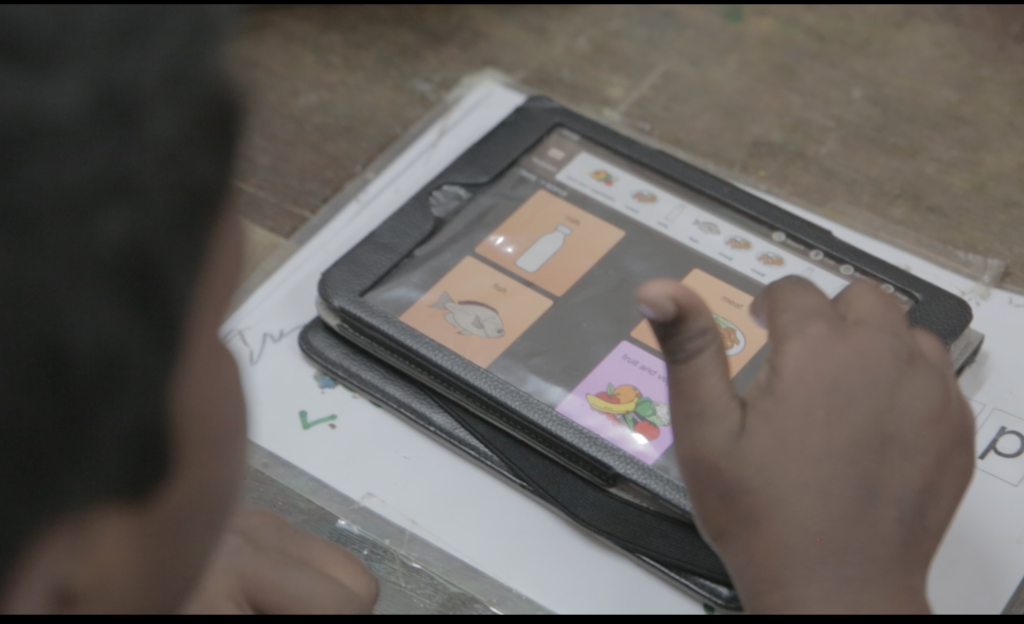As parents & caregivers, we are rightfully concerned about the amount of time our children spend with their screens. But should we be similarly concerned about high-tech AAC? Does it also count as screen time for children? Here’s SLP Niveditha’s take on this.


Screen Time and Children
Tabs and smartphones are inseparable parts of our lives. Every single person in the house owns at least one. And today, so do our children.
Screen time for children has become a necessary evil. You do know that it’s not good – yet you can’t do without it. This is also a topic that is being researched a lot. A recent recommendation from the American Academy of Pediatrics is:
For children younger than 18 months, use of screen media other than video-chatting should be discouraged.
They have suggestions for other age groups as well.
In this backdrop arises the question- when a child is using High tech AAC, does that count as screen time too?
Let’s look at it a little deeper-
Screen Exposure at Home and Therapy
During speech language therapy, we see the therapist using tablets. In addition to AAC (as a Speech Generating Device), SLPs also use tablets to show stimulus material like pictures and videos. They may also use it to target a goal with relevant apps. Additionally, we may reward clients with screen time on recreational apps. This becomes a reinforcer for producing the target word .
At home, screen time is used for educational and recreational purposes. Its role as a reinforcement for expected behaviour is also part of this.
All of this adds up to long hours of screen time for the child.
What Does Research Say
Research is very clear as to how screen time affects the brain’s social, cognitive and attention development. This is especially true for people on the Autism spectrum.
According to the causation model of Autism, this exposure could affect the preference for reinforcement. Meaning, the child may seek and respond to audiovisual stimulation over normal social feedback. Put simply, while interacting with a screen, the child is not interacting socially with their parents, siblings, or others.
Hence, it is important to demarcate between when the child is using the device to communicate and engage vs self-stimulation. Many a time parents, caregivers, teachers and paraprofessionals may not differentiate between the two activities.
Is AAC Screen Time for Children?
We know that AAC devices are the most practical and effective way to support communication skills of nonverbal clients on the autism spectrum. Using dynamic display speech-generating devices is an absolute game-changer for improving communication skills. They influence their social and emotional well-being too.
Amidst all this, the crucial task is this. When AAC is introduced we should ensure that parents and children understand that this device is the students voice – not a screen to play with.
Using a dynamic display device does not have the same effect as screen time. This is because the nonverbal student is receiving a social reward for their input. It is, however, a balancing act to ensure it is used appropriately.
Hence, we cannot dismiss the benefits of using a screen device to communicate.
A Reminder for Parents
Having established that AAC is technically not screen time, as it is the child’s voice, here are some things parents should remember –
- AAC is an effective way to improve the communication skills of children struggling to communicate, especially nonverbal students.
- Only a dedicated device should contain the AAC system.
- AAC devices should be easily accessible to the child – as similar as as possible to a verbal person accessing their voice.
Guidelines for Non-AAC Educational App Use
If you feel that educational app usage cannot be avoided, here are some guidelines to keep in mind
- Consensus: The therapist, other team members and the parents should be on the same page regarding which apps to choose and their purpose.
- Mindful Use: When you introduce apps, do it mindfully. Explain to children – whose it is, when to use/ not use and why
- Parental Guidance: Parents should guide with app use. Don’t give the app and walk away from child. See how you can engage and interact with them.
- Set an Example: Parents should set an example- reflecting your own use of devices. You could voice out aloud.- talking about how you use it and how you don’t prioritise screen over other interaction
- Transfer deficit: Say a child can solve puzzles on screen. This does not guarantee that they will be able to solve similar puzzles off-screen. This is referred to as transfer deficit. Though children appear to learn things from screen, they learn better from actual interaction. Actual interactions also enable them to retain more.
- Emphasize social interaction: In group therapy or at home with siblings, see if kids can work together. Eg. working on a video together rather than doing it alone. Even if they are doing something on separate screens, it works as long as they are doing it together.
- Avoid use as reinforcement: Avoid using educational apps as reinforcement, since it can inadvertently reinforce isolation. Remember, the screen is not a babysitter
- Switch it up: In sessions, rather than giving the child the device, the therapist can hold the device and the child can say what to do.
Conclusion
Increased amounts of screen time among children is a cause for concern. But AAC usage does not count towards screen time. An AAC system is a child’s voice, hence a part of them. That said, screen time from other apps needs to be planned & managed judiciously. A few guidelines kept in mind will enable children to benefit from apps. And not be adversely affected by screen time 🙂



